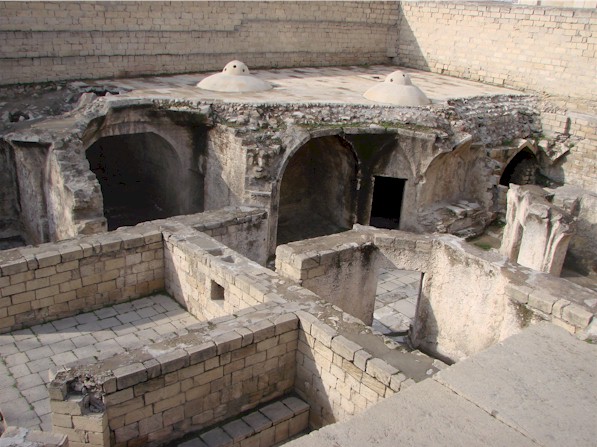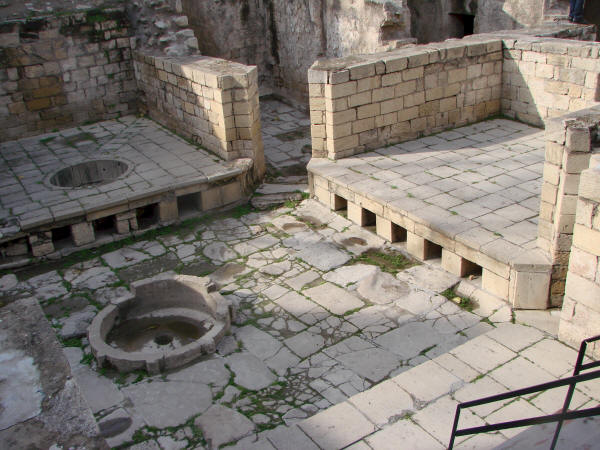Victorian Turkish Baths Picture of the Month for June 2011
Ruins of the hammam in the 15th century
Shirvanshah Palace, Baku (Azerbaijan)

Because this site is about the Victorian Turkish bath there are very few pictures of hot-air baths of any other type. Yet the hammam is still found throughout the Islamic world, and it kept the Roman bath alive after the fall of the Eastern Roman Empire. Without the Islamic hammam, it is extremely unlikely that there would ever have been a Victorian Turkish bath.
So our June Picture of the Month breaks with the tradition of this website in two ways because it is also dedicated to our son Michael and his bride Gamar, whose wedding we celebrated this month in Baku (after being invited to join Gamar's father Oktay for a bath in the Taza Bey Hammam which dates from 1886).
The Walled City of Baku with the Shirvanshah Palace and Maiden Tower were inscribed in 2000 as a unesco World Heritage Site.
According to the unesco website,
'the Walled City of Baku was built on a site inhabited since the Palaeolithic period and reveals evidence of Zoroastrian, Sasanian, Arabic, Persian, Shirvani, Ottoman, and Russian presence in cultural continuity. The Inner City (Icheri Sheher) has preserved much of its 12th-century defensive walls. The 12th-century Maiden Tower (Giz Galasy) is built over earlier structures dating from the 7th to 6th centuries BCE, and the 15th-century Shirvanshahs' Palace is one of the pearls of Azerbaijan's architecture.
'The Palace was built in the 15th century, when Baku finally became the capital. Construction proceeded during the reigns of Shirvanshah Khalilulla I and his son, Faruk, until the latter was killed in battle in 1501. The palace was seriously damaged by a Russian naval bombardment in the 18th century and much of the upper parts were destroyed. Restoration work was carried out in the 18th-20th centuries. Treasures from the palace, initially taken to Tabriz, were subsequently transferred as booty to the Topkapı Palace in Istanbul.
'The complex comprises several discrete elements: the residential part, the Divankhane, the Shirvanshahs' mausoleum, the Palace Mosque with its minaret, the baths (hammam), the Mausoleum of the Court Astrologer Seyid Yahya Bakuvi, the slightly later Eastern Gate, and the mosque of Key-Gubad. The palace is built on the highest point of one of the hills within Icheri Sheher. Extending over three superimposed terraces, it is clearly visible from the sea and from the heights surrounding the city. Entry is into an open courtyard at the upper level, which provides access both to the Divankhane and the residential part of the palace.
'In the lowest part of the palace are the ruins of the Palace bath-house, discovered in 1939 during excavations in a vineyard. Its plan consists of two large rectangular structures divided into smaller ones by four columns, with a separate furnace building for producing the steam [sic] taken through underfloor channels to the bath. Sections of the original wall tiles survive in some of the rooms.'
These underfloor channels can clearly be seen in the lower image.

Although the unesco text suggests that the bath was heated by steam passing through the channels, this seems less likely than hot air—which the Romans normally used in their hypocausts. Steam seeping through any cracks in the floor would be dangerous as the human body is scalded by steam whereas it can stand much hotter temperatures in dry air. This point needs further research.

Victorian Turkish Baths: their origin, development, and gradual decline



Comments and queries are most welcome and can be sent to:
malcolm@victorianturkishbath.org
The right of Malcolm Shifrin to be identified as the author of this work
has been asserted by him
in accordance with the Copyright, Designs and Patents Act 1988
© Malcolm Shifrin, 1991-2023